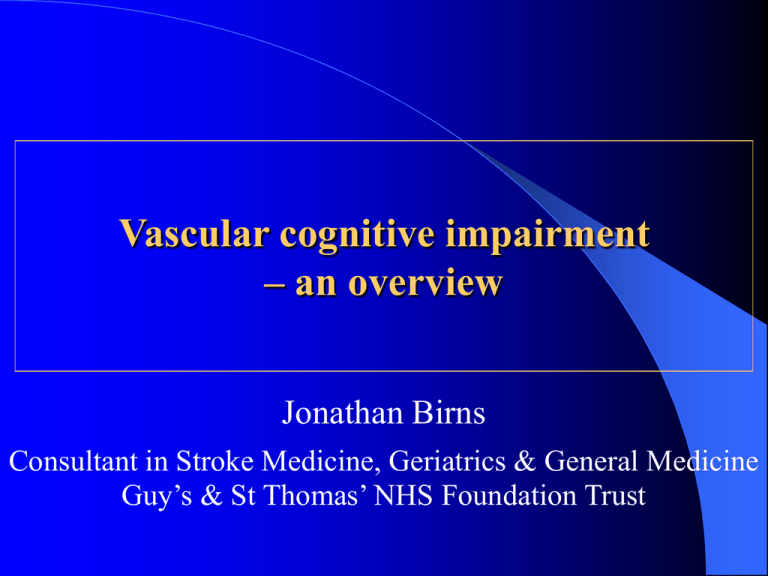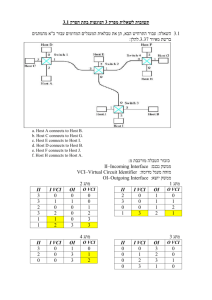JB VCI presentation - the HIEC Stroke Events Website
advertisement

Vascular cognitive impairment – an overview Jonathan Birns Consultant in Stroke Medicine, Geriatrics & General Medicine Guy’s & St Thomas’ NHS Foundation Trust Vascular cognitive impairment (VCI) encompasses all forms of cognitive loss associated with cerebrovascular disease and ischaemic brain injury related to: – Stroke – Cortical infarcts – Subcortical infarcts – Silent infarcts – Strategic infarcts – White matter lesions associated with small vessel disease – Specific arteriopathies e.g. CADASIL Vascular cognitive impairment (VCI) plays an important role in patients with other forms of dementia most common form of cognitive impairment in older people prevalence: 5% in people > 65 likely to increase Objectives To review VCI: – Pathology – Pathophysiology – Characteristic cognitive deficits – Therapeutic implications Background The cerebral circulation has a well developed collateral circulation which plays an important protective role Communications between the cerebral arteries at the circle of Willis Anastomoses between branches of the external carotid artery and the intracerebral circulation Anastomoses between cerebral vessels on the brain surface Vascular Territories of the Cerebral Hemisphere Vascular Territories of the Cerebral Hemisphere An internal watershed region exists in the deep white matter between centripetal and centrifugal arterial networks Centripetal supply to white matter Centrifugal supply to white matter Perfusion of the deep white matter Supplied by perforating end-arteries (< 400 mm in diameter) Each end-artery gives off perpendicularly oriented short branches Each branch provides the blood supply to a cylindrically shaped metabolic unit One distributing vessel irrigates one metabolic unit Cerebral small vessel disease Perforating arteries undergo age-related, arteriosclerotic changes - intimal atheroma formation - medial smooth muscle hypertrophy - hyaline deposition Arteriosclerosis is accelerated by disease states such as chronic hypertension and diabetes mellitus Cerebral small vessel disease Cerebral small vessel disease Pathophysiological mechanisms in VCI Risk factors for VCI E.g. age, ethnicity, hypertension, diabetes mellitus, cigarette smoking, ischaemic heart disease, hyperfibrinogenemia Vascular risk profile scoring measures correlate inversely with subcortical cognitive performance Evidence suggests that: – control of vascular risk factors could prevent VCI – treatment of vascular risk factors should reduce VCI once present Cerebrovascular Diseases 2008; 25: 408-416 p<0.001 Clinical features of VCI Strategic lacunar infarcts - abrupt onset of cognitive impairment and/or striking behavioural effects - often associated with lacunar strokes involving: - inferior genu of internal capsule - thalamus - caudate nucleus Clinical features of VCI Cognitive impairment and gait apraxia that may be subtle and insidious in onset These clinical manifestations result from: cortical-subcortical and corticocortical disconnection, due to white matter tract disruption, compromising the integration of information from large-scale neural networks Diffusion tensor imaging MRI - measures the diffusion of water molecules in biological tissues - used to study white matter properties and alterations of fibre integrity Clinical features of VCI A number of distinct fibre systems have been described: - dorsolateral prefrontal-subcortical circuits mediating executive function - orbitofrontal-subcortical circuits providing frontal inhibition of the limbic system preventing impulsivity and uninhibited behaviour - anterior cingulate-subcortical circuits whose interruption results in apathy and abulia Acute left anterior cerebral artery territory stroke presenting as mutism with abulia for contralateral function Birns J, Siddiqui A, Holmes P, Rudd AG. BJHM (in press) 74 year-old lady Pre-existing treated hypertension Awoke with: – Mutism – Lack of initiation – Urinary incontinence O/E – Mute but no receptive dysphasia – Spontaneity for left-sided actions but lacking volitional right-sided functions both spontaneously and to command – ‘Lead-pipe’ increase in tone in the right upper limb – Extensor right plantar response Acute left anterior cerebral artery territory stroke presenting as mutism with abulia for contralateral function Birns J, Siddiqui A, Holmes P, Rudd AG. BJHM (in press) Clinical features of VCI Cognitive deficits of subcortical VCI are variable Impairment of attention and executive function with slowing of motor performance and information processing predominate Clinical features of VCI VCI may be clinically silent to the physician Executive dysfunction impacts on ability to undertake complex, goal-directed, purposeful ADLs Relatives and carers may report: – abnormal behaviour – reduced speed of cognitive processing – personality changes Clinical features of VCI Episodic memory is relatively spared Cognitive impairments associated with subcortical VCI are not readily identified by commonly used measures » Attention and processing speed tests and assessments of executive function are better at discriminating patients with subcortical VCI Assessments for subcortical VCI Tests sensitive to impairments in: - Attention - Information processing - Executive function Tasks include: Digit span tests Forwards Backwards 27 381 4587 38416 715046 2849369 83516093 257361843 9406271351 35 742 8496 38519 829514 8374139 91526732 629816429 8749261451 Verbal fluency tests Phonemic –F –A –S Semantic – E.g. animals Choice reaction time test Stroop test Trail making test Digit symbol substitution test Therapeutic implications Primary prevention Secondary prevention Journal of Hypertension 2006; 24: 1907-1914 Effect of BP reduction on cognitive function Review: Comparison: Outcome: Blood pressure reduction and cognitive function - a meta analysis 01 Blood pressure reduction versus control 08 Decrease in delayed logical memory score Study or sub-category N Treatment Mean (SD) 183 16 62 34 73 -1.20(3.10) 0.20(3.00) -0.34(0.00) -1.30(3.00) -1.00(2.01) 168 16 59 35 71 368 Total (95% CI) Test for heterogeneity: Chi² = 0.90, df = 3 (P = 0.83), I² = 0% Test for overall effect: Z = 3.01 (P = 0.003) 349 Veterans Affairs McCorvey et al. Leonetti et al. HOPE Fogari et al. Control Mean (SD) N WMD (fixed) 95% CI -0.60(3.30) 0.00(3.00) -0.50(0.00) -0.50(3.20) -0.20(2.00) 42.27 4.41 -10 -5 0 Favours treatment Review: Comparison: Outcome: Weight % 5 WMD (fixed) 95% CI 8.90 44.41 -0.60 [-1.27, 0.07] 0.20 [-1.88, 2.28] Not estimable -0.80 [-2.26, 0.66] -0.80 [-1.46, -0.15] 100.00 -0.67 [-1.11, -0.23] 10 Favours control Blood pressure reduction and cognitive function - a meta analysis 01 Blood pressure reduction versus control 04 Change in trail making test A time Study or sub-category Veterans Affairs McCorvey et al. HOPE MRC (diuretic) N Treatment Mean (SD) 183 16 34 633 -10.20(34.30) -1.00(10.00) -8.00(22.00) -10.92(1.10) 866 Total (95% CI) Test for heterogeneity: Chi² = 1.06, df = 3 (P = 0.79), I² = 0% Test for overall effect: Z = 22.26 (P < 0.00001) N 168 16 35 1311 Control Mean (SD) WMD (fixed) 95% CI Weight % -11.60(35.10) 0.00(10.00) -5.00(19.00) -12.04(0.90) 0.02 0.02 0.01 99.95 1530 100.00 -10 -5 Favours treatment 0 5 Favours control 10 WMD (fixed) 95% CI 1.40 -1.00 -3.00 1.12 [-5.87, 8.67] [-7.93, 5.93] [-12.71, 6.71] [1.02, 1.22] 1.12 [1.02, 1.22] Why? Heterogeneity - study populations, cognitive domains, treatment strategies ? Minimal cognitive decline in study participants ? Over-representation of cognitively impaired patients who withdraw, die, lost to follow-up etc Battery of tests used to assess cognitive function might be insensitive to small changes ? increase in cerebral microbleeds in patients given aspirin Symptomatic treatment Nimodipine Cholinesterase inhibitors Memantine Conclusions Subcortical white matter harbours an internal watershed vulnerable to ischaemia Chronic ischaemic damage to the deep white matter interrupts cortical-subcortical and corticocortical pathways VCI is characterised by executive dysfunction As the baby boomer generation reaches 65 to 70 years by 2015, we will experience the predicted upswing in dementia






